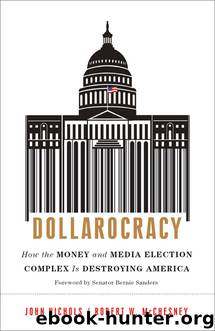Dollarocracy by John Nichols

Author:John Nichols [Nichols, John and McChesney, Robert W.]
Language: eng
Format: epub, mobi
ISBN: 9781568587110
Publisher: Nation Books
ELECTION COVERAGE IN RECENT TIMES
If we begin with the idea that the election coverage in the partisan era tended to be rich and engaging because the broader political journalism was rich and engaging, and that the political journalism of the professional era is rather staid, decontextualized, and establishment-oriented by comparison, we should not expect to have especially useful election campaign journalism today. Put another way, if political journalism does a relatively unsatisfactory job of covering public policy issues and drawing people into civic life, we should not expect campaign journalism to be any different. And it isn’t. Most of the main trends and great weaknesses in campaign coverage Americans lament today became dominant only in the last four or five decades.
Most accounts of the postwar era, specifically the 1950s and 1960s, characterize news media coverage as being very much in the professional mode: descriptive and deferential toward officeholders and politicians. That changed as broadcast media began to redefine campaign coverage.51 By the late 1960s and the 1970s, professional journalism enjoyed its Golden Age, when it had its largest budgets, most autonomy from owners and commercial pressures, and greatest prestige in the twentieth century. The news media also became increasingly important as a factor in determining electoral success. The news media filled some of the void as New Deal party loyalty dissipated and parties became less important as organizing tools in American politics. The number of “independent voters” grew, and straight-ticket party-line voting became less dominant. The importance of news media became especially clear with the emergence of television. As we note in Chapter 4, already by 1960 political campaigns were concerned with getting the best possible TV exposure, and initially the emphasis was on news coverage. Print media remained important, in part because the campaign beat reporters had considerable influence on TV coverage. The tenor of the campaign coverage then underwent a metamorphosis. Patterson’s research demonstrated that the framework of election stories in the New York Times went from 92 percent descriptive/8 percent interpretive in 1960 to 20 percent descriptive/80 percent interpretive by 1988.52
Timothy Crouse captured the emerging role of the news media in his classic account of the working press during the 1972 campaign, The Boys on the Bus: “Now the press screened the candidates, usurping the party’s old function. By reporting a man’s political strengths, they made him a front runner; by mentioning his weaknesses and liabilities, they cut him down. Teddy White, even in his wildest flights of megalomania, had never allowed himself this kind of power. The press was no longer simply guessing who might run and who might win; the press was in some ways determining these things.”53
Former Democratic senator from Alaska Mike Gravel, whose career in Washington began around this time, described the news media “echo chamber” as the decisive element for political success, especially for the White House. “Before most Americans start paying attention to the presidential race, the echo chamber has already promoted certain candidates over others and given them tremendous advantages that prove extremely difficult for other candidates to overcome.
Download
This site does not store any files on its server. We only index and link to content provided by other sites. Please contact the content providers to delete copyright contents if any and email us, we'll remove relevant links or contents immediately.
The Secret History by Donna Tartt(18808)
The Social Justice Warrior Handbook by Lisa De Pasquale(12126)
Thirteen Reasons Why by Jay Asher(8767)
This Is How You Lose Her by Junot Diaz(6761)
Weapons of Math Destruction by Cathy O'Neil(6116)
Zero to One by Peter Thiel(5661)
Beartown by Fredrik Backman(5575)
The Myth of the Strong Leader by Archie Brown(5403)
The Fire Next Time by James Baldwin(5224)
How Democracies Die by Steven Levitsky & Daniel Ziblatt(5111)
Promise Me, Dad by Joe Biden(5077)
Stone's Rules by Roger Stone(5013)
100 Deadly Skills by Clint Emerson(4824)
A Higher Loyalty: Truth, Lies, and Leadership by James Comey(4822)
Rise and Kill First by Ronen Bergman(4683)
Secrecy World by Jake Bernstein(4619)
The David Icke Guide to the Global Conspiracy (and how to end it) by David Icke(4606)
The Farm by Tom Rob Smith(4421)
The Doomsday Machine by Daniel Ellsberg(4397)
